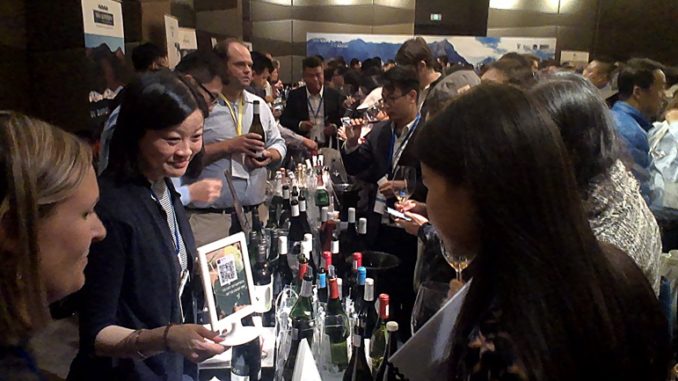
By Jim Boyce | Hot, crowded and no glasses: a first impression of yesterday’s Wines of South Africa roadshow at Westin Chaoyang Beijing. Luckily, the producers and distributors made up for it—once you got a vessel and pressed through the swaying lines of sweaty imbibers.
By imbibers, I mean plenty of people between tipsy and drunk, partly because such events are on the boozing circuit—New Zealand one day, Napa the next—and partly because there were few spittoons. I arrived jeg-lagged and intended to spit. But with no convenient place to expectorate, there is tendency to gulp the sample so you can move to the next wine. In turn, you end up on a slippery sloppy slope to being yet another sweaty imbiber.
Before I get to the vino, I’ll note that South African wines do well in our annual Grape Wall Challenge, where we ask Chinese consumers to blind taste wine. That South Africa offers soft fruity wine newcomers typically like as well as complex options for aficionados. And that so do many other nations, thus it is hard to gain market share with the multi-city tours pursued by everyone. (China Customs ranks South Africa seventh for volume and value in 2016.)  Finally, I went to this tasting due to a heads up and invite from Ross Sleet of Rascallion—I hope to do a Q&A with him soon.
Spier was my favorite table, both for its wines and the explanations of them by Henriette Jacobs and Carol Lang. (Jacobs stapled their business cards together. Who brings a stapler to a tasting!? But I easily found the cards this morning. Well-played.)
I started at Spier by swirling wine out of my glass and onto the guy behind me, thus underscoring the need for spittoons. But once I got that first Spier wine into my mouth—‘Signature’ Chenin Blanc—I had found my wine of the day, an excellent blend of price and taste. This unoaked beauty had stone fruit and slight green and floral smells and was fruity, well-balanced and playful. It retails for under rmb110. Winner!
A few people said it was priced too low. But what’s wrong with South Africa having wine that people can cite as superb value and that serves as a starting point for exploring a portfolio, region or country? What’s the alternative? To raise the price so people shrug their shoulders? There will always be good wines that offer better value—Kanaan ‘Pretty Pony’ from Ningxia is a local example—and help promote the overall scene.
Anyway, Spier’s barrel-fermented ’21 Gabels’ Chenin Blanc is a nice contrast to the entry-level drop and even tastier: it had a smoky buttery mild citrus aroma and elegant ripe fruit. It is also pricier. This is the wine I would buy after enjoying that entry-level Chenin Blanc, which, in turn, I would buy at the current rmb1a0 but likely not at, say, rmb210. I also liked Spier’s ‘Private Collection’ Cabernet Sauvigon 2015, aged 16 months in oak, for its fresh velvety soft fruit, though it retails for about rmb700.
Then there is Tall Horse, distributed by mega-player COFCO, known best for its Great Wall wines. I tried five horsies with Nick Sonderup of rep DGB and Nina Zhang of COFCO. The soft ripe Merlot and semi-sweet Muscat are the kind of wines that will turn on newcomers. And COFCO is perfectly poised to push into smaller markets although these wines strike me as best priced below rmb100 given the likes of Two Oceans and Obikwa. I also tried some of the Boschendal wines at this table. Nice stuff.
A few other wines tried:
- Bombinate means to make a buzzing noise. This Shiraz-Grenache blend from Rascallion has lots of dark fruit and a savory element. I can imagine guzzling a bottle at a barbecue.
- Anthonij ‘Rupert‘ Serruria Chardonnay: zingy stone fruit and nice oak both on the nose and in the mouth. Serruria is a flower also known as ‘blushing bride’ and ‘pride of Franschhoek’.
- Rupert’s ‘Protea‘ Cabernet Sauvignon 2015: it has complexity amid soft ripe juicy fruit and struck me as something to which entry-level wines might lead. I’ll admit I might have been influenced by the beautiful bottle!
- I also tried nice wines from Glenelley, including ‘Lady May’ Cabernet Sauvignon; an appealing cool-climate Pinot Noir from Broad Valley; and bubbly from Van Loveren, although my taste buds were pretty much exhausted by that point. There was also a white Cabernet from Asara that looked interesting but had already been emptied by the time I made it to the table.
With that, I headed off far giddier than I had hoped but happy to have tried some nice wines. But follow-up is everything in this business because everyone from Australia and Argentina to Barossa to Burgundy have their own wines, stories and pitches in the queue. Without follow-up, it’s Spier today, gone tomorrow.
Follow Grape Wall on Facebook and Twitter. Support the project here. And sign up for the China wine newsletter below. Also check out sibling sites Beijing Boyce and World Baijiu Day.
Grape Wall has no sponsors of advertisers: if you find the content and projects like World Marselan Day worthwhile, please help cover the costs via PayPal, WeChat or Alipay.
Sign up for the free Grape Wall newsletter here. Follow Grape Wall on LinkedIn, Instagram, Facebook and Twitter. And contact Grape Wall via grapewallofchina (at) gmail.com.

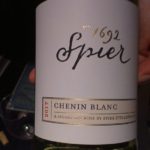
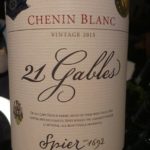
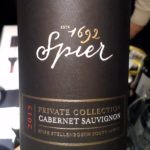
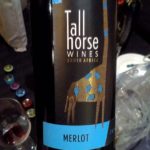
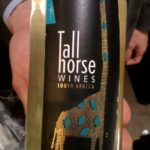
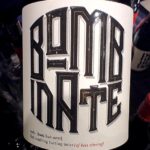
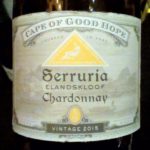

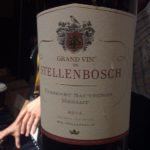

Leave a Reply
You must be logged in to post a comment.